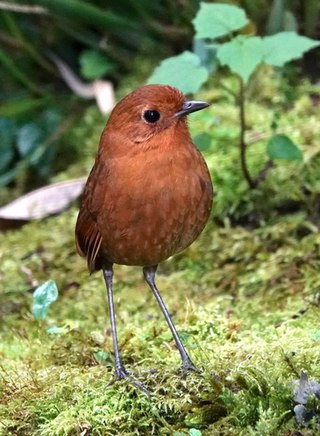
The white-throated antpitta is a species of bird in the family Grallariidae. It is found in Argentina, Bolivia, and Peru.

Grallaria is a large genus of Neotropical birds in the antpitta family Grallariidae.

The chestnut antpitta is a species of bird in the family Grallariidae. It is endemic to Peru.

The bicolored antpitta is a species of bird in the family Grallariidae. It is found in Colombia and Ecuador.

What is now the rufous antpitta complex was long considered to be a single species, Grallaria rufula, with seven subspecies. In 2020 G. rufula was found to be a species complex of 16 species, some of which were newly described. In 2021 the International Ornithological Committee and the Clements taxonomy implemented the split of the rufous antpitta into multiple species and accepted the newly described species. The revised Grallaria rufulasensu stricto, now called the Muisca antpitta, has no subspecies and is thus monotypic according to those taxonomies. However, BirdLife International's Handbook of the Birds of the World (HBW) did not fully implement the split. It retains the name rufous antpitta for Grallaria rufula and retains six of the seven previous subspecies within it. It had split only the former G. r. saltuensis as the Perija antpitta in 2018.

The Chami antpitta is a species of bird in the family Grallariidae. It is endemic to Colombia.

The Cajamarca antpitta is a species of bird in the family Grallariidae. It is endemic to Peru.

The equatorial antpitta is a species of bird in the family Grallariidae. It is found is Colombia, Ecuador, and Peru.

The Perija antpitta is a Near Threatened species of bird in the in the family Grallariidae. It is endemic to the Serranía del Perijá on the border of Colombia and Venezuela.

The Sierra Nevada antpitta is a species of bird in the family Grallariidae. It is endemic to the Sierra Nevada de Santa Marta in northern Colombia.

The Chachapoyas antpitta, or Graves's antpitta, is a species of bird in the family Grallariidae. It is endemic to Peru.

The Panao antpitta, also known as O'Neill's antpitta, is a species of bird in the family Grallariidae. It is endemic to Peru.

The Bolivian antpitta is a bird in the family Grallariidae. The species was first described by James Bond and Rodolphe Meyer de Schauensee in 1940. It is endemic to Bolivia. It is a member of the rufous antpitta species complex and was elevated from subspecies to species in 2020 on the basis of differences in plumage and vocalizations.

The Puno antpitta is a species of bird in the family Grallariidae. It is found in Bolivia and Peru.

The Urubamba antpitta is a bird in the family Grallariidae. The species was first described as a subspecies by Frank Chapman in 1923. It is endemic to Peru. It is a member of the rufous antpitta species complex and was elevated from subspecies to species in 2020 on the basis of differences in plumage and vocalization. The same study also described a new subspecies of Urubamba antpitta.
The Muisca antpitta is a bird in the family Grallariidae. The species was first described by Frédéric de Lafresnaye in 1843. It was formerly called the rufous antpitta, which in 2020 was found to be a species complex composed of as many as 15 species, some of which were newly described. It is found in the Andes of northern Colombia and western Venezuela.

The Oxapampa antpitta is a species of bird in the family Grallariidae. It is endemic to Peru.

The Ayacucho antpitta is a species of bird in the family Grallaridae. It is endemic to Peru.

The Atuen antpitta, or southern tawny antpitta, is a species of bird in the family Grallariidae. It is endemic to Peru.




















